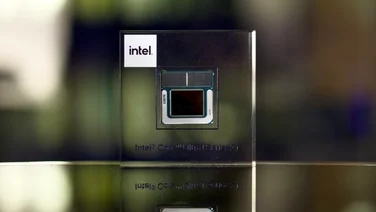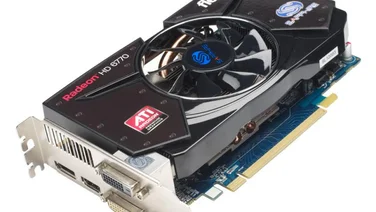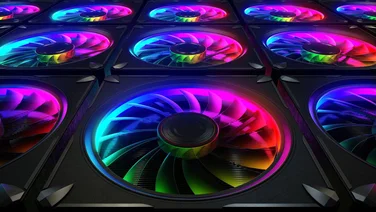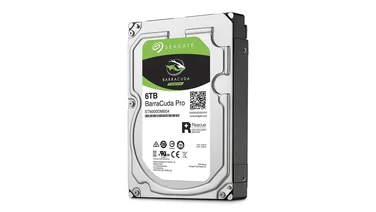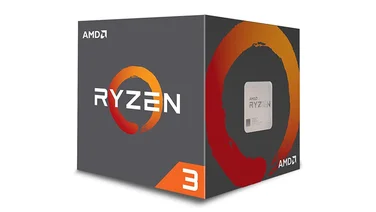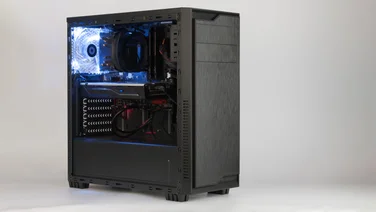To help us provide you with free impartial advice, we may earn a commission if you buy through links on our site. Learn more

OVERVIEW
The Radeon R7 250 is the cheapest AMD GPU which is capable of playing modern games at 1,920×1,080 at reasonable detail levels. The R7 250 can also get all the power it needs from the PCI Express socket, so doesn’t need an extra PCI Express power connector. A standard R7 250 graphics card, such as the Sapphire R7 250 model below, is based on the AMD Oland XT architecture, with 384 GPU cores and a core 1GHz clock speed.
Confusingly, Sapphire’s passively-cooled Radeon R7 250 is actually a rebranded Radeon HD 7750, so is based on the Cape Verde PRO core, with 512 GPU cores and an 800MHz clock speed. This architecture is a couple of years old, but as we show below, the GPU can still hold its own in games
The faster R7 250X is based on the Cape Verde architecture, and the stock design has the same 1GHz clock speed as the R7 250. However, the R7 250X has 640 GPU cores, so is significantly quicker. The last of AMD’s budget cards we’ve tested is the R7 260X. This has a Bonaire XTX GPU, and its 896 GPU cores run as standard at 1,150MHz, representing a significant step up from the Radeon R7 250X.
| Card | Rating | Award | Price inc VAT | Supplier |
| Sapphire Radeon R7 250 1GB | 3 | £68 | www.ebuyer.com | |
| Sapphire Ultimate R7 250 | 4 | £77 | www.ebuyer.com | |
| Sapphire Vapor-X R7 250X | 3 | £86 | www.ebuyer.com | |
| MSI R7 260X | 5 | Best Buy | £89 | www.ebuyer.com |
INDIVIDUAL CARDS
Sapphire Radeon R7 250 1GB
The Sapphire Radeon R7 250 1GB is the only AMD card we’ve tested slim enough not to block the expansion slot underneath it when fitted. It’s also only 150mm long, so will fit in all cases apart from low-profile ones. The card is unusual in having a VGA port for older monitors and has HDMI, but the DVI port is only single-link. This means the highest-resolution monitor the card can drive over a digital connection is 1,920×1,200, so those wanting to use 2,560×1,440-pixel or higher screens should look elsewhere.
The card is bus-powered, so you certainly won’t need a power supply upgrade to install it. It’s not a powerful card, however. In our least-challenging game test, Dirt Showdown, at our standard Desktop PC settings of 1,920×1,080, Ultra quality and 4x anti-aliasing, the card managed an average 25.2fps, with the frame rate sometimes dropping as low as 19.8fps. This is too slow for smooth gameplay, but dropping the quality to High bumped up the frame rate to a much smoother 46.2fps.
In our tougher Tomb Raider test, which we run at 1,920×1,080 with Ultra quality and 2xSSAA (see the Buying Guide for an explanation of how SSAA works) the card managed just 15.9fps. Switching SSAA for the less-demanding FXAA and dropping detail to High made this jump up to a playable 32.8fps.
Our toughest game test is the Metro: Last Light Redux post-apocalyptic shooter. At our standard settings of 1,920×1,080 with Very High detail and tessellation and SSAA enabled, the R7 250 could only manage a crawling 8fps. To make the game playable we had to drop detail to Low and turn off tessellation and SSAA, which gave us 41fps, but the game isn’t nearly as pretty at these settings. The R7 250 isn’t a bad card for its low price, but an extra £20 or so will get you the much quicker MSI R7 260X, which is more capable in the latest games.

Sapphire Ultimate R7 250
If you’re building a quiet PC, such as one to sit under your TV in the living room, you may be interested in a passively cooled card such as the Sapphire Ultimate R7 250. This has a large heatsink so can do without a fan entirely, and like the standard R7 250 doesn’t need an external power connector. We set it running a game test on repeat for an hour in an enclosed PC case, and had no problems with overheating. Bear in mind that the card is 120mm high (around 15mm higher than a standard R7 250) so check it will fit in your case. As well as HDMI, the card has dual-link DVI and DisplayPort outputs, so can handle ultra-high-resolution displays.
Confusingly, even though it’s badged as a Radeon R7 250, the Sapphire Ultimate card is in fact a rebadged AMD Radeon HD 7750. It’s based on a Cape Verde PRO GPU from 2012, with 512 GPU cores running at 800MHz. The card has a lower clock speed than the standard R7 250, but the increased number of stream processors leads to slightly better performance. The Ultimate R7 250 was a couple of frames a second faster than the R7 250 in Dirt Showdown with Ultra detail, but 27.4fps isn’t quite enough for smooth gameplay. The card had no trouble with the test once we dropped detail levels to High, managing 62.4fps.
Our standard Tomb Raider settings of Ultra quality and 2x SSAA were too much for the Ultimate R7 250, as a jerky 16.9fps shows, but dropping detail to High and using less-high-quality FXAA anti-aliasing brought the frame rate up to a playable 35.5fps. To get a playable frame rate in the very challenging Metro: Last Light we had to drop detail to Low and turn off SSAA and tessellation, but at these low levels we saw a playable 46fps average. If you want a silent card but still want to play modern titles, the Sapphire Ultimate R7 250 is a good card if you don’t mind sacrificing some detail. Those after silence and performance should find the extra cash for the Zotac GeForce GTX 750 Zone Edition.

Sapphire Vapor-X R7 250X
Next up in AMD’s range is the Sapphire Vapor-X R7 250X. This is a twin-fan design, and is quiet at idle and under load. It requires an external power connector, and there’s a Molex to 6-pin PCI Express adaptor in the box in case your PSU doesn’t have the right plug. Along with HDMI, the card has twin dual-link DVI outputs and DisplayPort, so you’ll be able to use 2,560×1,440 and 3,840×2,160 displays.
Thanks to 640 GPU cores running at 1,100MHz, the card has some fair gaming clout. It managed a playable 42fps in our Ultra quality Dirt Showdown test, and Tomb Raider was nearly playable at Ultra quality with 2x SSAA enabled, with 25fps. Once we reduced Tomb Raider’s quality settings to High and used FXAA anti-aliasing, we saw a very smooth 50fps average.
Metro: Last Light Redux was more of a challenge, and at our standard Very High settings we only saw 12fps from the R7 250X. Dropping to High quality and turning off SSAA led to a playable average of 31fps, but this still dropped to a jerky 15fps minimum in some parts of the benchmark.

MSI R7 260X
The Sapphire R7 250X is a fair budget card, but spending a few pounds more on the MSI R7 260X will get you a significant performance boost. The R7 260X’s 896 GPU cores and mild 25MHz overclock helped it to a very smooth 52.8fps in the Ultra quality Dirt Showdown benchmark, and the card could even manage a playable 35.9fps once we brought the resolution up to 2,560×1,440.
Even in the tougher Tomb Raider test, the R7 260X managed a just-playable average of 31fps with Ultra quality and 2x SSAA. In Metro: Last Light at Very High settings, we only saw 14fps, but turning off SSAA and dropping to High quality led to a playable 39fps average. Considering it costs only around £5 more than the R7 250X, and is over £20 less than the Nvidia GTX 750 Ti-based cards, the R7 260X is a bit of a performance bargain. It wins a Best Buy award.


